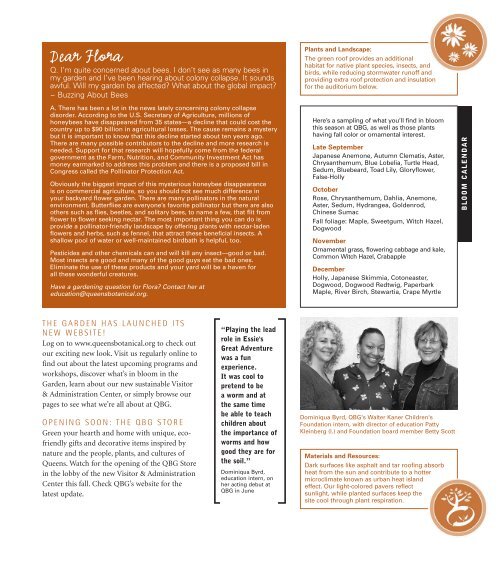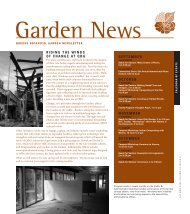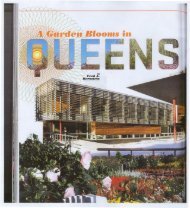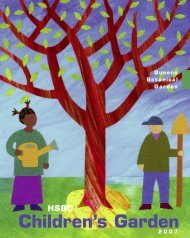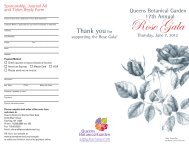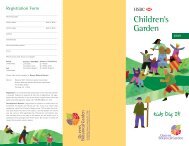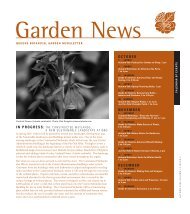Garden News - Queens Botanical Garden
Garden News - Queens Botanical Garden
Garden News - Queens Botanical Garden
You also want an ePaper? Increase the reach of your titles
YUMPU automatically turns print PDFs into web optimized ePapers that Google loves.
Dear FloraQ. I’m quite concerned about bees. I don’t see as many bees inmy garden and I’ve been hearing about colony collapse. It soundsawful. Will my garden be affected? What about the global impact?~ Buzzing About BeesA. There has been a lot in the news lately concerning colony collapsedisorder. According to the U.S. Secretary of Agriculture, millions ofhoneybees have disappeared from 35 states—a decline that could cost thecountry up to $90 billion in agricultural losses. The cause remains a mysterybut it is important to know that this decline started about ten years ago.There are many possible contributors to the decline and more research isneeded. Support for that research will hopefully come from the federalgovernment as the Farm, Nutrition, and Community Investment Act hasmoney earmarked to address this problem and there is a proposed bill inCongress called the Pollinator Protection Act.Obviously the biggest impact of this mysterious honeybee disappearanceis on commercial agriculture, so you should not see much difference inyour backyard flower garden. There are many pollinators in the naturalenvironment. Butterflies are everyone’s favorite pollinator but there are alsoothers such as flies, beetles, and solitary bees, to name a few, that flit fromflower to flower seeking nectar. The most important thing you can do isprovide a pollinator-friendly landscape by offering plants with nectar-ladenflowers and herbs, such as fennel, that attract these beneficial insects. Ashallow pool of water or well-maintained birdbath is helpful, too.Pesticides and other chemicals can and will kill any insect—good or bad.Most insects are good and many of the good guys eat the bad ones.Eliminate the use of these products and your yard will be a haven forall these wonderful creatures.Have a gardening question for Flora? Contact her ateducation@queensbotanical.org.Plants and Landscape:The green roof provides an additionalhabitat for native plant species, insects, andbirds, while reducing stormwater runoff andproviding extra roof protection and insulationfor the auditorium below.Here’s a sampling of what you’ll find in bloomthis season at QBG, as well as those plantshaving fall color or ornamental interest.Late SeptemberJapanese Anemone, Autumn Clematis, Aster,Chrysanthemum, Blue Lobelia, Turtle Head,Sedum, Bluebeard, Toad Lily, Gloryflower,False-HollyOctoberRose, Chrysanthemum, Dahlia, Anemone,Aster, Sedum, Hydrangea, Goldenrod,Chinese SumacFall foliage: Maple, Sweetgum, Witch Hazel,DogwoodNovemberOrnamental grass, flowering cabbage and kale,Common Witch Hazel, CrabappleDecemberHolly, Japanese Skimmia, Cotoneaster,Dogwood, Dogwood Redtwig, PaperbarkMaple, River Birch, Stewartia, Crape MyrtleBLOOM CALENDARTHE GARDEN HAS LAUNCHED ITSNEW WEBSITE!Log on to www.queensbotanical.org to check outour exciting new look. Visit us regularly online tofind out about the latest upcoming programs andworkshops, discover what’s in bloom in the<strong>Garden</strong>, learn about our new sustainable Visitor& Administration Center, or simply browse ourpages to see what we’re all about at QBG.OPENING SOON: THE QBG STOREGreen your hearth and home with unique, ecofriendlygifts and decorative items inspired bynature and the people, plants, and cultures of<strong>Queens</strong>. Watch for the opening of the QBG Storein the lobby of the new Visitor & AdministrationCenter this fall. Check QBG’s website for thelatest update.“Playing the leadrole in Essie'sGreat Adventurewas a funexperience.It was cool topretend to bea worm and atthe same timebe able to teachchildren aboutthe importance ofworms and howgood they are forthe soil.”Dominiqua Byrd,education intern, onher acting debut atQBG in JuneDominiqua Byrd, QBG's Walter Kaner Children'sFoundation intern, with director of education PattyKleinberg (l.) and Foundation board member Betty ScottMaterials and Resources:Dark surfaces like asphalt and tar roofing absorbheat from the sun and contribute to a hottermicroclimate known as urban heat islandeffect. Our light-colored pavers reflectsunlight, while planted surfaces keep thesite cool through plant respiration.


